One of the best advances in diabetes care is the continuous glucose monitor (CGM). It has been a game changer for my patients. They are easy to use, affordable, clinically proven to be accurate and some like the Freestyle Libre don’t even need any fingerstick glucose readings for calibration. They provide a wealth of information to the patient and the doctor. Not knowing your glucose is driving with your eyes closed. A CGM is a valuable GPS helping you navigate through the challenges of glucose fluctuations arising from variety of factors like food, exercise, stress, infection, sleep deprivation. It can help you arrive at your goal A1C destination safely, effectively and in a timely manner. In my practice, I use the Freestyle Libre 14-day system in all my patients.
Here are some frequently asked questions from my patients:
What is the Freestyle Libre system? Freestyle Libre 14-day System is a CGM device indicated for replacing blood glucose testing and consists of two main parts; a handheld reader and a disposable sensor worn on the back of the upper arm. The sensor is painless and checks your interstitial fluid glucose continually every minute and stores it every 15 minutes for 14 days. You scan the sensor with the reader and obtain your readings in real time. The sensor comes factory calibrated thereby eliminating the need for finger pricks. NFC enabled smartphones running Android OS 5.0 or higher and iPhone7 or later can also be used as the reader. You will need to download the free “Freestyle LibreLink app”.
How do I place the sensor on my arm? Check out this YouTube video on how to place the sensor.
Where should I place my sensor? The approved site is on the back of your upper arm. If you sleep on your side especially on your arm, I suggest not using that arm to place the sensor. Avoid placing the sensor on loose skin since it may give you falsely low readings.
What steps can I take from preventing it from falling off? Ensure that applicator and sensor pack are connected and engaged on a hard surface and press down firmly and count to 5. Clean back of the upper arm with soap and water and let it dry. Next clean it with alcohol wipes and let it air dry. When applying the applicator pack to skin, press firmly while counting to 5. After placement, press one finger firmly on adhesive around sensor. Utilize Skin Tac as extra barrier for allergies or adhesion. If your sensor keeps getting dislodged when you place it on the outer surface of your arm, try placing it on the inside of your upper arm. Remember it is a work in progress. You don’t have to get it right the first time. If your sensor falls off prior to 14 days despite taking all these precautions, I suggest you call Freestyle Libre. They have a fantastic replacement policy.
Can I shower with it? Sensor can be worn while bathing, showering or swimming as long as it is not exposed to water beyond a depth of 3 feet or for longer than 30 minutes. Yo do not need to cover it.
Does the sensor hurt when I insert it? It does not hurt while putting it on or taking it off. You will not notice it on you. That is why it is important to be aware of it on your arm especially while clothing and unclothing to prevent it from coming off.
How much does it cost? As of 2020, most insurances in the US are covering it for an average copay of $40 per month.Go to myfreestyle.us to get 1 free 14 day sensor. You doctor will need to send a prescription. The reader costs another $65 but you can use your smartphone instead and download the “Freestyle LibreLink App” for free.
Do I need to prick my finger while using this sensor? You do not need to prick your finger unless the reader specifically advises you. It will do so only if it detects sudden changes in your glucose numbers.
When should I scan my sensor? Scan as many as times as you can when you are awake. I recommend scanning every one hour. Your goal is to keep your glucose in your target range as often as you can. Scan more frequently if you notice your glucose is outside your target range. Also scan more frequently if you are introducing new foods, starting a new exercise regimen, starting new medications, new work schedule etc.
Besides food, what will raise and lower my glucose? You will notice your glucose numbers will be high if you are stressed or experiencing discomfort, taking certain medications like steroids, on days following nights when you did not get adequate sleep and when you begin exercising. Your numbers will come down following exercise and will continue to drop for many hours depending on the intensity and duration. Alcohol will drop you glucose as well.
Can I share my glucose data with my doctor? Yes. I strongly encourage all my patients set up an account on www. LibreView.com and share their data with me so I can monitor their numbers outside of our visits and review valuable reports during our virtual visits. Here is a video on how you can set up your LibreView account to begin uploading, viewing and sharing your glucose with your doctor. You can also call Customer Support at 855-786-4263.
You will need your doctor to either send you an email invitation or share their practice ID with you. If you are using the Freestyle LibreLink app, your data is automatically uploaded to LibreView with every scan allowing your doctor to see the data as soon as it is available.
Will the readings be the same as my glucometer? Not always. The sensor is measuring your interstitial fluid glucose and not your blood glucose. Look at the image below to see how they will vary especially when you sugar rises following meals or falls following insulin dosing or physical activity.
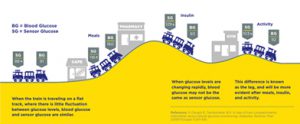
How do I use my reader to understand my glucose? When you scan the sensor with the reader, you will see a sensor glucose number, an arrow next to the number and glucose tracing for the preceding 8 hours. Focus on patterns and not just the number. Look at the number (112), then look at the arrow next to the number showing the direction your glucose is heading and finally look at the trend graph showing the last 8 hours of glucose history. This will educate you on how prior meals, exercise, medications, sleep or other activities influence your glucose helping you make educated decisions in the future and knowing what’s coming ahead will guide you on what steps to take to bring your glucose back in the target range.
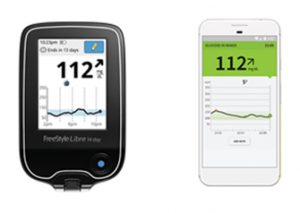
Libre Reader Libre Link App
You also have valuable reader reports available on the reader. Here is a summary.
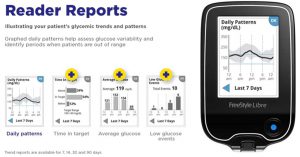
What do all the graphs mean? Every patient’s glucose pattern is unique and varies from time to time for the same patient. It’s important to review your own glucose patterns so you can take the right action in a timely manner. The reader will save data for 90 days. I suggest looking at the following options periodically at least once a week and comparing last 7 days to last 14, 30 and 90 days.
Types of Graphs you can see:
Daily Patterns. This will show you when your glucose is in the target range or when it is above or below your target.
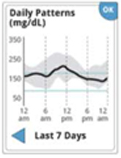
The goal is to keep your readings in your target range as often as possible. You will feel your best when your sugars are fairly steady and do not fluctuate too much.
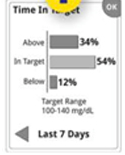 Time in Target: Target range is usually set at 70-180. Aimfor 70% or higher readings in target. It is estimated that every 10% increase in target results in 0.8% reduction in hemoglobin A1C.
Time in Target: Target range is usually set at 70-180. Aimfor 70% or higher readings in target. It is estimated that every 10% increase in target results in 0.8% reduction in hemoglobin A1C.
Average glucose: Aim for average below 150 mg/dl (with no lows). Look at the bars to identify when your average glucose tends to be the highest and make the necessary lifestyle modifications to keep it under 150.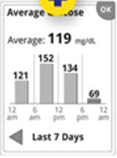

Low glucose event: aim for 0 events. Hypoglycemia is a dangerous and debilitating condition. Contact your health care provider and make prompt adjustments to your diabetic medications to prevent them in the future.
Remember these numbers are just that-numbers. Don’t mistake them for who you are. Notice if you become critical and judgmental. Be kind to yourself. Accept the number for what it is and use the knowledge to make better decisions in the future so you can thrive with diabetes

 Dr. B Paul on Diet Doctor Podcast!
Dr. B Paul on Diet Doctor Podcast!